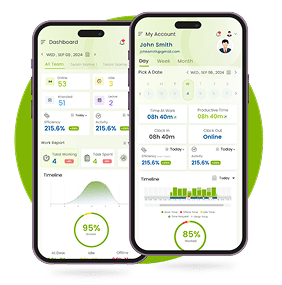The biggest challenge for employees isn’t just managing tasks, it’s managing focus. With constant workplace distractions, notifications, and meetings, sustained concentration has become a rare skill.
Yet, neuroscience reveals a simple truth: focus is cyclical, not constant. Humans work best in short bursts of effort followed by recovery. This is where timed breaks, like those enabled by Desklog’s Timed Activities feature, play a transformative role.
They don’t just prevent burnout; they rewire how teams work, ensuring productivity, creativity, and wellbeing flow together naturally.
Overview:
- Why the Brain Needs Structured Pauses
- The Productivity Science Behind Timed Breaks
- Understanding Desklog’s Timed Breaks Feature
- Turning Breaks into a System of Flow
- Reducing Stress and Preventing Burnout with Data
- How Breaks Improve Focus in Remote and Hybrid Teams
- From Fatigue to Flow: A Practical Framework
- Final Thoughts
- FAQs
Why the Brain Needs Structured Pauses
Human attention isn’t limitless. Studies show focus wanes after 90 minutes of intense work. Without deliberate pauses, fatigue accumulates, leading to poor judgment, errors, and employee burnout.
How the Brain Resets Through Pauses
Timed breaks activate the brain’s default mode network, responsible for creativity and insight. During these moments of rest, employees subconsciously process information and make new connections, fueling innovative thinking.
Applying Time Management to Mental Recovery
Frameworks like the Pomodoro Technique embody strong time management principles. Short breaks every 60–90 minutes restore attention, protect energy, and improve time efficiency, helping the brain stay sharp throughout the day.
The Productivity Science Behind Timed Breaks
While many organizations strive to maximize employee performance, they often overlook the cost of overwork. Sustained stress drains focus and motivation, reducing output over time.
Balancing Effort and Energy
Strategic pauses improve energy regulation and prevent overextension. Desklog’s Break & Overtime Notification alerts employees before exhaustion sets in, helping maintain a steady rate of employee efficiency across projects.
Tracking Productivity in Cycles
When employees schedule recurring breaks, companies can measure employee productivity in realistic focus cycles rather than raw hours. This shift creates more sustainable and meaningful performance analytics.
Understanding Desklog’s Timed Breaks Feature
The Timed Breaks feature in Desklog introduces science-backed structure into daily routines. It allows organizations to schedule recovery periods precisely, ensuring balance across teams.
What Are Timed Activities?
Timed Activities are scheduled breaks set at specific times of the day, say, a 1:00 PM lunch break lasting 1 hour. They run exactly at their configured time, regardless of ongoing activities.
Duration and Enforcement Options
Each activity includes:
- Time: The start time (e.g., 1:00 PM)
- Duration: How long the break lasts (e.g., 1 hour)
- Enforce Option: When enabled, it switches the user offline automatically, ensuring compliance and genuine rest.
How to Enable Timed Breaks
- Go to Settings and select Wellness Module.
- Find Timed Activities and toggle the Enable/Disable button.
- Click Add to include activities like lunch or short breaks.
- Choose from categories and activate the Enforce Option.
This automation ensures employees take restorative breaks without manual reminders, building healthier work habits naturally.
Turning Breaks into a System of Flow
Breaks shouldn’t be accidental, they should be strategic. When leaders treat rest as part of performance, teams transition from stress to flow.
Visualizing Effort with Time Mapping
Desklog’s time mapping dashboard visualizes team activity across hours and projects. Managers can identify focus peaks and fatigue dips, improving workload distribution and avoiding imbalances.
Team Time Management in Action
Integrating team time management practices ensures everyone works within synchronized rhythms. This structured approach helps teams collaborate effectively without overwhelming individual members.
Building Flow-Driven Cultures
When timed breaks become cultural norms, employee engagement deepens. Employees learn to value rest as a productivity enabler, not a distraction.
Reducing Stress and Preventing Burnout with Data
The connection between rest and wellness is data-backed. Desklog’s wellness dashboards help HR leaders monitor how break patterns affect employee satisfaction and efficiency.
How Breaks Improve Focus in Remote and Hybrid Teams
In remote setups, work and rest boundaries often blur, leading to silent overwork. That’s why remote employee management insights have become essential to maintaining wellbeing and focus.
Reinforcing Accountability in Remote Environments
Desklog helps reinforce employee accountability by automatically recording activity patterns. Managers can identify when to encourage breaks or realign schedules.
Aligning with the Pillars for Managing Remote Teams
Regular breaks support the pillars for effectively managing a remote team, structure, communication, and trust. They ensure employees perform optimally without burnout.
Supporting Attendance and Balance
Desklog simplifies how to manage remote employee attendance by linking active hours with scheduled breaks, ensuring balanced work-life balance for distributed teams.
From Fatigue to Flow: A Practical Framework
To build a flow-based culture, organizations need a balance between focus and rest. Here’s how:
1Adopt the 90-Minute Cycle
Work in 90-minute focus sessions followed by 10–15 minutes of rest. This rhythm aligns with the brain’s natural energy cycles, sustaining focus and preventing mental fatigue.
2Schedule Micro-Breaks
Include 2–3 minute pauses every 45 minutes for stretching or breathing. Micro-breaks keep attention sharp, prevent stiffness, and reduce digital fatigue throughout the day.
3Use Time Tracking Tools
Use automated time tracking systems like Desklog to gain visibility into real work patterns. Features such as clock-in & clock-out tracking and activity insights help identify peak performance periods and ensure breaks happen before exhaustion sets in.
4Prevent Overwork
Integrated wellness breaks through Desklog’s Wellness Module, which sends automatic reminders for rest and relaxation. This helps employees recover consistently and prevents burnout from excessive workloads.
5Encourage Team-Wide Adoption
Make scheduled breaks a shared practice across departments. Collective rest times promote fairness, inclusivity, and better collaboration while supporting consistent productivity.
These steps merge performance and wellness, helping teams move from fatigue-driven effort to sustained flow.
Final Thoughts
Timed breaks are no longer a perk, they’re a productivity imperative. Supported by Desklog’s intelligent time tracking, automation, and wellness dashboards, they transform how employees work and recover. By redefining focus through rhythm, structure, and empathy, organizations can move from stress-driven output to flow-driven success, one well-timed pause at a time.
Start Your Flow Journey Today
Experience the power of structured breaks with Desklog.
FAQs
1 What are timed breaks and why are they important?
Timed breaks are structured pauses during the workday that help employees rest and reset their focus. Studies show that concentration drops after 60–90 minutes of continuous work, leading to mental fatigue. Scheduled breaks help restore energy, improve attention span, and prevent stress buildup. When built into daily routines or managed through platforms like Desklog, they promote consistent productivity and better overall wellbeing.
2 How do timed breaks differ from casual breaks?
Casual breaks are unplanned and spontaneous, while timed breaks follow structured intervals based on productivity principles. Casual breaks may disrupt focus, but timed breaks are deliberate, ensuring rest occurs before performance declines. This approach helps maintain concentration, reduce decision fatigue, and build a steady work rhythm throughout the day.
3 How does Desklog’s Timed Breaks feature work?
Desklog automates scheduled pauses through its Timed Breaks feature. Managers can set up break durations, intervals, and modes, like Strict, Moderate, or Flexible, to match team needs. During these periods, Desklog can activate offline mode to pause tracking, encouraging complete rest. It ensures recovery is intentional, not optional, supporting long-term focus and productivity.
4 Can timed breaks improve productivity in remote teams?
Yes. In remote setups, employees often overwork without realizing it. Timed breaks help set boundaries, manage screen fatigue, and prevent burnout. Desklog reminds team members when to take breaks, promoting a rhythm that keeps them alert and motivated. This structured rest supports work-life balance and helps remote teams maintain consistent efficiency across different schedules.
5 How do timed breaks prevent burnout?
Burnout results from prolonged effort without recovery. Timed breaks interrupt this cycle, allowing mental and physical recharge. These brief pauses help stabilize mood, renew focus, and maintain long-term energy levels. When employees consistently take structured breaks, automated through Desklog, they experience less exhaustion and perform more steadily over time.
6 Can Desklog measure the impact of breaks on performance?
Yes. Desklog provides break analytics that track performance before and after scheduled breaks. The data highlights how rest patterns affect task completion, focus, and activity levels. This helps managers fine-tune break schedules for maximum impact, turning rest periods into a measurable performance improvement tool.
7 How do breaks help in managing absenteeism?
Structured rest reduces workplace absenteeism by addressing fatigue and stress early. When employees regularly recharge, they’re less likely to experience burnout-related issues or take unplanned leave. Desklog’s scheduled breaks promote a balanced routine, helping teams stay healthier, more engaged, and consistently present.
8 Are timed breaks suitable for all job roles?
Yes, timed breaks benefit every role, creative, technical, or managerial. They enhance mental clarity for complex problem-solving, refresh creativity, and prevent fatigue. Desklog’s customizable settings allow each department to align break frequency with their workflow, making structured rest a universal productivity booster.

















